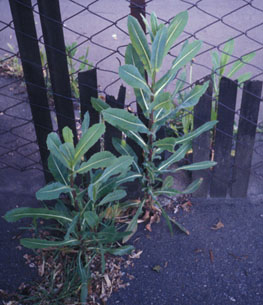
|
| Prickly Lettuce; Lactuca Serriola L. |
| = Lactuca Scariola L. |
Sunflower Family; COMPOSITÆ (ASTERACEÆ)
|
| Prickly lettuce is an annual or biennial herb that is thought to be the ancestor of common cultivated lettuces. It serves thereby, as
an example of what plant-breeders are capable of. |
| The seeds frequently sprout in autumn, and by late winter or early spring the young plants make good eating: bearing large leaves
that are still sufficiently mild flavored to be acceptable tasting. In summer, the weed bolts up as high as 9 feet tall, its much-branched stalk
of bluish-green leaves holding hundreds of small (a third of an inch), pale yellow, Dandelion-like flowers, which open in the morning
and close in the afternoon. Airy seed puffballs, also of Dandelion fashion, but smaller, follow; they are very pretty when seen on a dewy morning. |
| The leaves are about the size of Dandelion leaves but usually lack the prominent jagged lobes. Even if lobed, they differ from
Dandelion leaves by invariably having rows of tiny, weak spines around their edges and down the center on the underside: hence the name
Prickly Lettuce used for this species. |
| The plant should not by any means be confused with Miner's lettuce
(Montia genus, a delicate woodland wildflower, also edible),
or Blue-flowered Lettuce (seen mostly east of the Cascades). Besides being known as Wild or Prickly Lettuce, this weed is called
Compass Plant: the stem leaves are often seen pointing roughly north / south and east / west, with one edge tilted upward markedly. In shadier
sites they don't do this as much; indeed this Wild Lettuce dislikes shade. Wall Lettuce
(Mycelis or Lactuca muralis) is common in shady
areas, including woodlands. It, too, is edible. |
Though Prickly Lettuce is common, it is relatively little known by name. Gravelly sites and sunny, bare or disturbed ground are
where it grows. It certainly is undemanding. As an edible, this lettuce is less bitter than its Dandelion and Chicory cousins, yet no better to
eat than Cat's-Ear (Hypochæris), Nipplewort
(Lapsana), or Sow Thistle (Sonchus). It is not watery and crunchy like Iceberg Lettuce, but
does have real flavor and nutrition. So let us eat lettuce. Don't let the weed grow big and become bitter, and under no circumstances let it reseed.
|
Originally published as the Seattle Tilth newsletter Weed of the Month in April 1988, along with an illustration drawn by Sylvan Haven.
Back |
|
|

